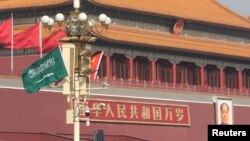Saudi Arabia’s Crown Prince Mohammed bin Salman arrived in Beijing on Thursday for a two-day visit to boost the country’s international image sullied by the recent killing of Saudi journalist Jamal Khashoggi and to enhance economic ties. But the path to better ties between Saudi Arabia and China is riddled with political hurdles.
China has spent the last few days assuring Iran, Saudi Arabia’s political rival, that the Crown Prince’s visit would not affect its approach to the Middle East. Chinese President Xi Jinping told visiting Iranian Parliament Speaker Ali Larijani on Wednesday that his resolve to develop a comprehensive strategic partnership with Iran will remain unchanged.
Saudi Arabia, a Sunni country, and Iran where most people belong to the Shia Muslim sect, have been engaged in a long standing struggle for influence in the Middle East.
For Beijing, it’s a delicate balancing act between Saudi Arabia, which is seen as a close ally of the U.S., and Iran, which is openly critical of Washington.
“China has been good at keeping a kind of subtle balance between Iran and Saudi Arabia,” Jean-Pierre Cabestan, professor of politics at the Hong Kong Baptist University said.
Beijing needs support from both wealthy Muslim nations at a time when it is engaged in a trade war with the U.S. and a major slowdown in its economy. It also needs Saudi support for the Belt and Road program, which has not yet made much of a mark west of Pakistan.
Mutual concerns
Beijing’s own relationship with Riyadh has not been very smooth. “The relationship [of China] with Saudi Arabia has never been easy,” Cabestan said.
One issue is Iran. “The other issue [between China and Saudi Arabia] is more religious because it has to do with the restrictions imposed on the Chinese Muslims in China. Not only the Uighur but also the Hui people in Ningxia,” he said.
The Saudi leadership has to worry about its image in the Muslim world and close association with China involves some risks. But China has its own worries about engaging too closely with Saudi Arabia.
“China is very worried about any kind of Wahabi influence on its Muslims. And that has always been a kind of objective limitation to any kind of friendship or close cooperation and understanding between the two countries,” Cabestan said.
The Saudi Crown Prince introduced a new element to this delicate relationship by emerging as an investment rival in Pakistan, which is the showcase country for China’s prestigious Belt and Road program.
He announced a $20 billion investment in Pakistan, half of which will go to building an oil refinery in Gwadar next to a Chinese built port in the coastal city.
Though the investment would boost the China Pakistan Economic Corridor (CPEC), part of the Belt and Road program, it could also be a matter of concern for Beijing.
“In practice, a major additional investor in or close to Gwadar should represent a boost for CPEC but Beijing will be a little politically wary nonetheless,” said Andrew Small, author of “China-Pakistan axis: Asia’s new geopolitics.”
“For Pakistan, it does represent a gentle rebalancing away from dependency on China, which some on the Pakistani side think had grown excessive — even if China will remain a critically important partner,” he said.
But Imtiaz Gul, executive director of the Islamabad-based Center for Research & Security Studies, does not agree, The latest investment comes after consultations between China, Saudi Arabia and Pakistan to further develop CPEC, he said.
“Multilateral or bilateral relations are not defined by faith and ideologies. They are determined by economic interests, " Gul said.
Economic dimensions
The Saudi prince also offered to invest $100 billion in different projects across India. This is significant because India has been reluctant to adopt the Belt and Road program and accept Chinese investment offers related to it. The large scale Saudi entry into India’s investment market would reduce New Delhi’s need for Chinese money.
Though political aspects may pose problems, China and Saudi Arabia are expected to make some breakthroughs in economic areas.
There is an attempt to combine Saudi Vision 2030 with China’s Belt and Road program. Saudi Vision 2030 aims at diversifying the country from an oil-based economy to one that is a producer of exportable goods and services.
“Although Washington remains its most important strategic partner, Riyadh seems to be preparing for a post-oil era, by enhancing its cooperation with other countries, which it hopes can bring about more chances to deepen cooperation with emerging economies, so as to improve its ability to withstand economic and political risks by putting its eggs in different baskets,” said Niu Song, a researcher in Middle East studies at Shanghai International Studies University.
China hopes to win more oil projects like the Yanbu refinery in Saudi Arabia while Riyadh wants to attract Chinese investment in infrastructure construction, housing, and tourism development.













